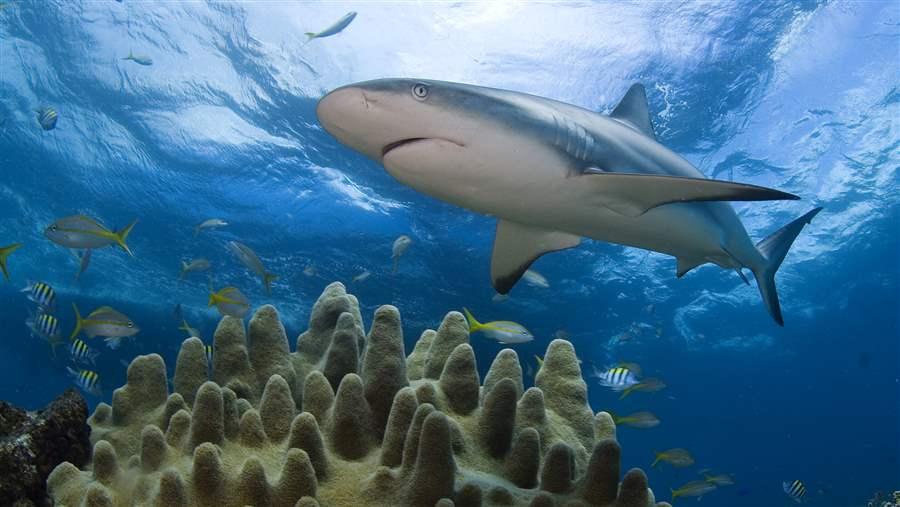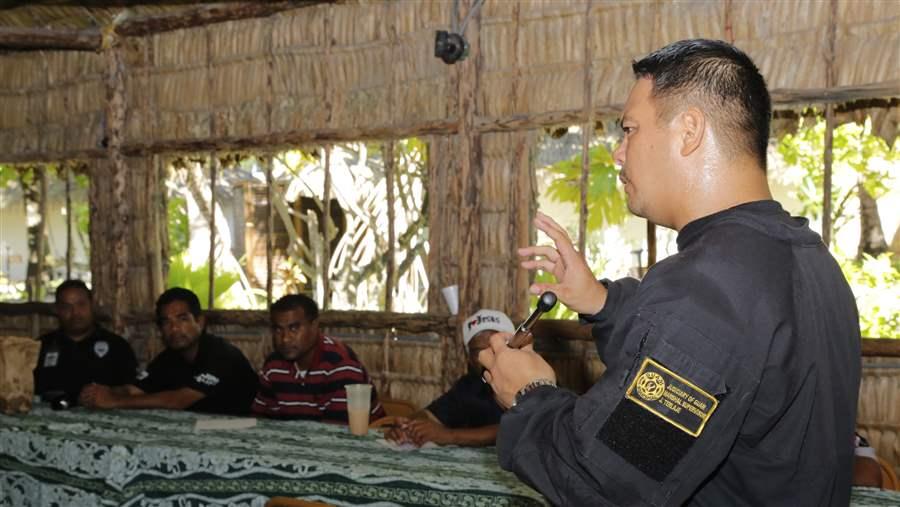Shark Sanctuary Compliance Guide
 Jim Abernethy
Jim AbernethyA Caribbean reef shark in its natural habitat.
Shark populations around the world are in serious trouble. About 100 million sharks are killed each year in commercial fisheries, and nearly 30 percent of all known shark species assessed by scientists are threatened with extinction. Coastal and island governments can help turn the tide by creating sanctuaries to protect all shark species within their waters. Shark sanctuaries prohibit all commercial fishing for sharks and retention of sharks caught as bycatch within a country’s full exclusive economic zone (EEZ). These important conservation measures keep sharks protected; they also provide valuable ecosystem, environmental, and economic benefits.
Shark sanctuary enforcement
Most shark sanctuaries are in the waters off small island developing states with EEZs that are disproportionately large in comparison with their land area. These states often have limited budgets to dedicate to enforcement. That means monitoring and then acting when needed can be challenging, but both are possible. Countries that have established shark sanctuaries have implemented effective enforcement frameworks to ensure they can maintain high levels of compliance. Here’s why:
- Shark sanctuaries are streamlined and simple in concept. A complete prohibition on shark fishing—as opposed to a mix of steps such as species-specific prohibitions, catch limits, and time and area closures—makes it relatively straightforward for law enforcement officials to do their job. Mere possession of sharks or shark parts provides probable cause to take action.
- Shark sanctuaries are designed to be enforced by existing personnel using the resources already at their disposal. As a result, establishment of a sanctuary generally does not require hiring additional staff with special expertise or altering the workload of current staff. Agents can easily identify sharks among other fish. Because catching any shark species is prohibited, a broad range of officers in various law enforcement agencies—such as natural resources, customs, and immigration—can identify a violation with minimal additional training. The community also can help with policing by reporting infractions to authorities.
- Shark sanctuary laws can include a phase-in period to allow time for better education and community outreach to maximize the potential for voluntary compliance.
- Shark sanctuaries can fit into a flexible compliance framework that can be enhanced over time. Sanctuaries help conservation efforts, even if optimal levels of compliance are not achieved initially.
Improving compliance
Effective implementation of shark sanctuaries and ensuring optimum compliance involve a range of efforts, including educating the public, conducting outreach, and publicizing enforcement actions to help deter future violations. Among the factors that states should consider to boost compliance:
- A shark sanctuary law should be as strong as possible, with fines that match the high value of shark fins and not just the cost of doing business. If fines are minimal, individuals will view them as merely an added cost to their illegal activity, as opposed to a genuine deterrent.
- Banning the sale, trade, and possession of shark products—rather than just the fishing of sharks or the intentional fishing of sharks—makes it easier to prove that being in possession of a shark or shark products is an offense.
- Banning gear or fishing techniques used to target sharks has proved effective in reducing the possibility that commercial fishing vessels will catch sharks either intentionally or as bycatch.
- Rigorous port inspections of fishing vessels, in conjunction with other routine government inspections, can be an effective tactic for shark sanctuary enforcement. Countries should require that all transshipment of fish take place at designated ports or other areas where customs or fishery inspectors can easily access vessels and cargo.
- Adopting and implementing the U.N. Food and Agriculture Organization Agreement on Port State Measures to Prevent, Deter, and Eliminate Illegal, Unreported, and Unregulated Fishing (PSMA) will improve port enforcement.
- Requiring tamperproof vessel identification and tracking through the use of International Maritime Organization numbers can make it more difficult for pirate fishing vessels to operate. These unique ID numbers cost nothing and are already required on all large-scale commercial and maritime vessels.
- Opportunities for enforcement officers to collaborate and exchange information across national boundaries— both formally and informally—help focus attention on suspected vessels and their catch, and improve the tracking of criminal organizations.
 Shawn Heinrichs
Shawn HeinrichsJoey Terlaje, deputy marshal captain for the Superior Court of Guam, addresses attendees at an enforcement training in the Marshall Islands.
Support from The Pew Charitable Trusts
Only governments have the authority to enforce shark sanctuaries, but Pew can help with advocacy, outreach, and training. Pew has the resources to promote community activities such as training for customs and enforcement officials. These efforts can be tailored to a government’s unique needs. For example:
- In 2012, Pew partnered with The Bahamas National Trust and The Bahamas Department of Marine Resources to convene a workshop that resulted in the creation of a marine regulations booklet to inform fishermen about conservation laws.
- Between 2012 and 2014, Pew collaborated with the Micronesia Conservation Trust and the Pacific Islands Managed and Protected Area Community to conduct eight law enforcement trainings in the Freely Associated States of Micronesia. More than 200 officers earned certifications in shark sanctuary enforcement through those programs.
- More broadly, Pew partnered with the Satellite Applications Catapult in 2014 to pioneer Project Eyes on the Seas. The program’s cutting-edge technology can be used to monitor fishing vessels in order to identify suspicious fishing activities. In 2015, platform designers began a series of pilot projects in marine reserves and regulated fisheries.






